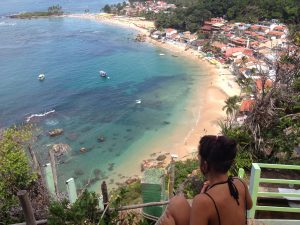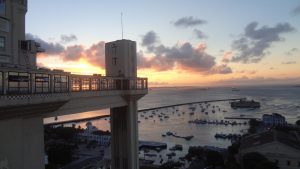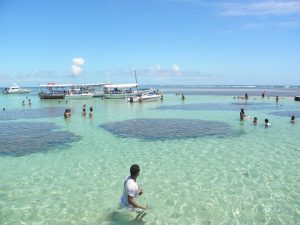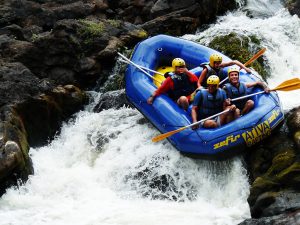Reasons to visit
Reasons to visit
Brazil
Of continental extension, Brazil reserves surprises at every destination. Tourists can enjoy the mountain climate and mountainous areas, beautiful waterfalls, rivers, beaches, plateaus, forests, among other wonders, and delight with every dish, every culture, every landscape.The diversity is also present in the wealth of habits, accents, religions and traditions. There are many nations within a single country. Indian influences, African, European, Asian, American and many others are present in the daily life of the Brazilian people. In some destinations this influence is so entrenched that we seem to be in other parts of the world. Only in Brazil is so much diverse.From North to South, you can find diverse landscapes and taste the most exotic ingredients, but what is common throughout the country is the friendliness of the Brazilian people. The enthusiasm with which foreign tourists reported the hospitality and the Brazilian joy recurs. The catchy and cheerful way to welcome its visitors with open arms is a major national attraction.
One of the most typical tourist destinations in Brazil is Bahia. As many tourists have found out, Bahia is not only Salvador, Porto Seguro and Carnival. The state has a number of options for those who want to rest in the beautiful beach destinations and what’s best: at any time of the year, as the constant good weather makes it possible to enjoy everything from ecotourism to adventure and water sports.
Bahia is just two a 2 hours flight from major Brazilian cities, and less than 8 hours flight from Lisbon, which has connection to all of Europe! There are over 900 km of beaches, of which 75km are located in the city of Salvador.The capital of Bahia, Salvador, receives 3 million tourists a year, nearly the size of its population – only during Carnival, 550,000 tourists arrive in the city, most of them to squeeze day and night behind the electric trios (sound cars), a legitimate Bahia invention.
Spend a few days over there enjoying the warmth and joy of its local people, you are also entitled to the bustle of neighbourhoods such as Rio Vermelho and historical tours of Brazil, especially in the Pelourinho area, with its studios, mansions and churches of the 18th century.So, if you go to Bahia for the obvious reasons – beach, heat and party – you will not be disappointed, of course. There are 1200 km of coastline and nearly 300 beaches: to party or for those who want peace and quiet, with resorts to distract the children or charming inns where the calmness and silence prevail.In the south of Salvador, there is the ‘Costa do Dendê’, as it is called the region of the Itaparica island, Morro de São Paulo and increasingly famous Boipeba island, which vies for attention with kilometers of sand and almost wild beaches.
Why visit us
 The cosmopolitan Morro de São Paulo is located on Tinharé Island, 248 km away from Salvador. Morro is one of the most coveted destinations of Costa do Dendê, which has environmental units with great ecological value and high degree of biodiversity, environmental quality of ecosystems and strong cultural traditions. The breath-taking scenery of Morro de São Paulo is inhabited by a rich and diverse array of flora and fauna. To get there you need to take a catamaran or a plane in Salvador. Or, go by car or bus to Valencia and from there take a boat or a speedboat. Morro has only four “exploited” beaches and two main streets, but there is room for everyone, literally. Young backpackers from south of Brazil, North America and even Europe arrive on the tiny harbour in search of the restless (and famous) night life of the village.
The cosmopolitan Morro de São Paulo is located on Tinharé Island, 248 km away from Salvador. Morro is one of the most coveted destinations of Costa do Dendê, which has environmental units with great ecological value and high degree of biodiversity, environmental quality of ecosystems and strong cultural traditions. The breath-taking scenery of Morro de São Paulo is inhabited by a rich and diverse array of flora and fauna. To get there you need to take a catamaran or a plane in Salvador. Or, go by car or bus to Valencia and from there take a boat or a speedboat. Morro has only four “exploited” beaches and two main streets, but there is room for everyone, literally. Young backpackers from south of Brazil, North America and even Europe arrive on the tiny harbour in search of the restless (and famous) night life of the village.
The buzz reigns in the Aureliano Lima Square and Caminho da Praia Street (packed with restaurants serving from homemade local food to Italian), extending to the Second Beach – the beaches are not identified by name, but in numerical order. The First Beach is about 300 meters and is the most popular beach by the natives and those who wish to practice sports. It is the only beach that has larger waves, so it ends up being perfect for surfers!
The island is also a destination for many couples and families who seek and find peace. Yes, the town is small, but has well-demarcated territories. If you are looking for some peace and quiet, the third beach is quiet, with some hotels and restaurants; while at the fourth, tranquillity reigns supremely. In these last two beaches, the natural pools of clear waters are perfect for diving. In addition to the “numbered” beaches, Morro still has the Encanto (or fifth), Gamboa and Guarapuá beaches. Gamboa beach is where you can find the famous clay wall, which is great for the skin. Take a bath on its waters and you will have a very soft skin! For those who live in large cities, Morro seems like a place out of this world. To begin with, there are no cars in the island. Everything is done by foot (everything is so close to each other that this is not a problem at all). There is no bad weather. When it rains, it lasts no more than 30 minutes and the sun returns to shine and all the clouds go away!
The people are very friendly and welcoming. They treat all tourists very well. Even those who are working are always smiling and cheerful! Things that are not so common in our day to day life in the city. You also don’t need shoes or fancy clothes. You’ll be wearing flip flops and bathing suits all day long, even at night!
What to do during the day?
Besides staying at the beach sunbathing, you can take boat trips around the island, go surfing, stand up paddle, kite surfing, etc. If the tide is low you can walk to Gamboa (it is about 25 minutes from Morro), said to have quiet and beautiful beaches! Morro has one of the longest zip line in Brazil and it is an amazing experience! You have a wonderful view from up there and you fall directly into the water.
What to do during the night?
The “night” begins before the sun goes down. From the beach, go straight to Toca do Morcego to see the most beautiful sunset of the island! There you can have drinks, eat and listen to local bands play.
 There are more things to see and do than just visit beaches.
There are more things to see and do than just visit beaches.
The mixture of races, cultures and beliefs, which received generous doses of joy and syncretism, gave Salvador a single trait that attracts Brazilians and foreigners all year. It is in the summer, however, that the capital of Bahia gets even brighter, with festivals which draw crowds behind religious images and of course, the electric ‘trios’ (big car sounds). From December until Carnival, Salvador boils!
Salvador, Brazil’s first capital, meets the present and the past in perfect harmony, and taking into account the topography of the city – divided into Upper and Lower parts – it is easy to map it and glimpse the attractive wide open on every corner. It is in the upper part which is the colorful ‘Pelourinho’, the historic district and listed by Unesco as a World Heritage Site. In its streets and alleys there are hundreds of houses of the 17th and 18th centuries that house museums to ‘Candomblé’, and Catholic churches that attract scholars from around the world – in the case of the ‘São Francisco’ church, considered the richest baroque work in Brazil.
To get to the lower part of the city you need to get in one of Salvador’s postcards: The Lacerda Elevator, which connects the two points. Once you are by the sea shore, exploring the beaches is crucial. Among the urban one, ‘Porto da Barra’ is the most democratic and busy.A little bit further away from the center, ‘Itapuã’, ‘Stella Maris’ and ‘Flamengo’ beaches have crystal clean water and heavy traffic on weekends. Halfway there, the Rio Vermelho neighborhood is where you can find the bohemians way of life and fans of the most famous ‘acarajés’ of Salvador, prepared by Bahia legends Dinha and Regina.Gastronomy wise, Salvador offers far beyond ‘acarajés’ a fried thing filled with ‘vatapá’ and dried shrimp. Typical recipes that blend perfectly indigenous, African and Portuguese ingredients, bring to you delicacies like ‘bobó’, ‘moqueca’ and ‘caruru’, always served with ‘dendê oil’.If you are in Slavador, there are many options a few kilometres apart.
One of them I recommend is to visit ‘Arembepe’. The beaches are beautiful, but the main attraction of the Arembepe is the hippie village. Installed close to a place called ‘centrinho’, home to many hippies that sells hand crafts and cassava to survive, preserve the virgin vegetation and live in houses made of mud and straw without electricity. The unspoilt scenery of thise community is still the same that enchanted and housed Mick Jagger and Keith Richards in 1968, and Janes Joplin in 1970.Arembepe is just 34 kilometers away from the trendy ‘Praia do Forte’, but retains the rustic in its beaches, edged by dunes that are golden at sunset. The look is still composed of coconut trees, reefs, natural pools and crystal clear lagoons.
Both Arembepe and Praia do Forte are home to the Tamar Project. Founded in 1980 by the Brazilian Institute for Forestry Development (IBDF) the Tamar Project aims to protect five species of sea turtles belonging to the Brazilian coast. In order to visit it, tourists have access to the base and can see tanks and fish tanks with the marine fauna of the region and the species of sea turtles. Those who wish can make guided visits to the Tamar Project and each activity has its day and scheduled time. To enter the project an admission fee is charged.

Morere, a paradise protected by the sea on the coast of Bahia.
‘Morere’ is a small fishing village that is part of the ‘Boipeba’ island, a few hours from Salvador, traveling by car, with a boat crossing, or in small airplanes. The main destination of this island is actually the Old Boipeba, where most of the restaurants, hotels and residents are located. Alongside Morro de São Paulo, it is part of the ‘Tinharé’ archipelago, in the ‘Dende’ Coast.
In recent years, the peaceful village residents have observed the construction of comfortable hotel developments. And they opened their own kitchens and their boats to serve tourists. So you can eat and sleep well in Morere, as it leverages the inner city scenery: soft sand streets, colorful houses, a small school and a chapel.
In the vicinity of Morere, there are beaches with endless white sandy tracks. Virtually all are contoured by palm trees. They were planted by farmers decades ago, but today they seem native, so integrated into the landscape. The water is always warm. There are even freshwater streams that mingle with salty and generally calm beaches. River or sea bathing, it is up to you.
One of the main attractions is the tour in the swamp area. The old fishermen and crab collectors are now tourist guides as they have a vast knowledge about species and biome behaviour. The tour lasts over an hour navigating huge mangroves in canoes. While the small vessel passes through paths formed by high roots, white dots in their thousands hiding in the dark and dense mud. They are crabs of varying sizes and types, frightened by the strange presence.
Although Morere is ideal for those seeking to escape from the tourist turmoil, especially in the high season, you should set aside one day to visit the Old Boipeba, whose habitation began in the sixteenth century. There you can find a small church of the early seventeenth century built by the Jesuits; it is called the Church of the Holy Spirit. From the eighteenth century, it served as a ground for various crops such as cocoa and coffee. Although old, it managed to keep its rustic features, and today the island is recognized as a World Heritage Site by Unesco.
From Morere to Old Boipeba, you can arrive by boat or tractor. But the most interesting is to make the journey by foot. It takes about two hours and is performed by the edge of the sea, so the view and the warm water overshadow the walking time. The tide must be taken into consideration. The ideal is to get out in the morning, if not, there is a high risk of crossing the Oritibe river, between the beaches of Morere and Cueira, with water on your chest, or not even being able to cross it.
The paradise of Morere includes natural pools of transparent water full of fish, beaches lined with coconut palms and mangroves everywhere. There are almost twenty kilometres of blue waters, where the highlight attraction being the Ponta dos Castelhanos, south of Boipeba – famous for housing under the sea the remains of the Spanish ship Madre de Dios, which sank there in 1535.
The local cuisine is an attraction by itself. In Tupi language, Moreré means “discus”, a famous fish in the region. Not by chance the few stalls and restaurants by the sea serve great food made of local delicacies and seafood, such as shrimp, octopus and lobsters. The big star of the island is the stew, present in all small home restaurants scattered across the sands of the small strip of sand. If hunger tightens, be sure to visit the ‘Mar e Coco’ restaurant and ask for a seafood ‘moqueca’ (stew) with plantain, a specialty of the island.
 Itacaré was once a haunt for cocoa farmers. It went into oblivion in the 60’s when a relentless plague led to the decay of the farms. It was only rediscovered 40 years later, with the inauguration of a new road. The tarmac has replaced the precarious dirt road, hitherto seen only by surfers that in the 70’s paved and maintained the anonymity of the abandoned piece of paradise.
Itacaré was once a haunt for cocoa farmers. It went into oblivion in the 60’s when a relentless plague led to the decay of the farms. It was only rediscovered 40 years later, with the inauguration of a new road. The tarmac has replaced the precarious dirt road, hitherto seen only by surfers that in the 70’s paved and maintained the anonymity of the abandoned piece of paradise.
With the easy access also came the hype, the perks – comfortable lodgings, sophisticated resorts, international restaurants, Internet cafes, shops… – and the constant movement of tourists.
Itacaré was reborn under the ecotourism blessings and has been growing in an orderly manner, preserving rivers, waterfalls and deserted beaches framed by hills covered with Atlantic Forest – a very different scenario of the main postcards of Bahia, with dunes and cliffs.
In order to keep everything in its proper place, the city will not give up on the tracks, the only way to reach the most enchanting sceneries, as ‘Prainha’ and ‘Havaizinho’. Kayaks, canoes, bikes and jeeps are also welcome to practice exciting sports or venture out amid spectacular scenery.
There is no such thing as escaping the nature of Itacaré. Beaches, rivers or the Atlantic Forest are always framing the tours and sports activities practiced in the region. Even at night the scene is based on nature – some ‘forró’ houses are by the sea and the most crowded parties take place in the beach sands.
Good waves, hills covered by the Atlantic forest, accessed through trails and little movement. These are the characteristics common to the most beautiful beaches of Itacaré: Prainha, Havaizinho, Engenhoca and Jeribucaçu. If you are not willing to face a good walk, the options are the central beaches – Concha and Ribeira have good infrastructure and are busy, while Tiririca (also with great waves) and Resende have a bucolic atmosphere.
Discovered by surfers, Itacaré today offers much more than good waves. The region is formed by forests, rivers, waterfalls and swamps, which make it one of the hottest ecotourism destinations in the country, encouraging the practice of adventures like rafting, rappelling, kayaking, mountain-biking, hiking… The beautiful scenery – sea and Atlantic forest – are common to all activities, which should always be practiced in the company of guides.
Rafting is probably the most famous adventure of Itacaré. It is practiced in the most famous river of the region, the river Contas. The descent lasts two hours and takes place in the most exciting part of the river – three kilometres of rapids between canyons.
The night life in Itacaré (in the summer) starts early and ends only when the day gives signs that it will lighten up. The forró music can be appreciated on specific weekdays and every weekend from 9 pm to midnight. In the city center, the Pedro Longo street (Pituba) has bars that crowd late at night. And, on the coastline of Coroinha (in the Historic Center), the Café e Boteco Vila offers drinks, foosball tournaments and live music from Thursday to Saturday.
A trip to Itacaré is suitable for couples, families or groups of friends who are looking for beaches and contact with nature. To make the most of the region it is necessary to make trails (easy / medium, 40 minutes in general). It can be visited all year, there are over 300 days of sunshine with an average annual temperature of 27 degrees and water temperature of 23-25 degrees.
A little bit further south you can find Serra Grande, a city built on top of a green hill overlooking the Atlantic Forest and the clear, blue sea. Through the highest part of the city known as the “Mirante da Serra”, you can let your mind wander away enjoying beautiful sunsets and having a cool drink on site. There are 22 km of white sand and coconut trees there for you to enjoy without any disturbance. Spend a day relaxing in front of the sea, where you can surf or simply stroll in what seems to be an endless beach. For those who are tired of salt water and waves, Serra Grande offers a quiet environment where there is fresh water. Near the city centre there is a large lake surrounded by a green lawn and trees that create a sense of a more private space. Admission is free.
